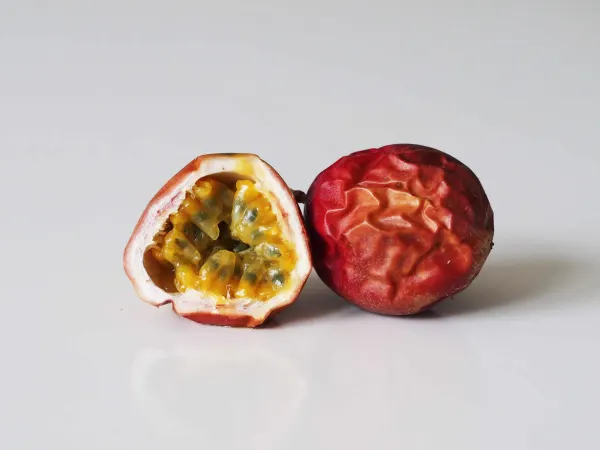Access our First Foods® Database in the Solid Starts App.
Learn morePassion Fruit
Fruit
Age Suggestion
6 months
Iron-Rich
No
Common Allergen
No

When can babies eat passion fruit?
The pulp of ripe passion fruit and its fiber-packed seeds may be introduced as soon as your baby is ready to start solids, which is generally around 6 months of age. However, note that the pulp of the unripe fruit, plus the leaves, peel, and skin of both the unripe and ripe fruit can be toxic.
Warning
The pulp of the unripe fruit, plus the leaves, peel, and skin of both the unripe and ripe fruit can be toxic. Ripe passion fruit is fragrant and has wrinkled skin.
How do you serve passion fruit to babies with baby-led weaning?
Every baby develops on their own timeline, and the suggestions on how to cut or prepare particular foods are generalizations for a broad audience.
6 to 9 months old:
Scoop out the gelatinous pulp (with the seeds) of ripe passion fruit and mix into to warm cereal or yogurt for hand-scooping (you can also serve passion fruit pulp on its own in a bowl if you desire.) If you want your baby to use a spoon, mix the passion fruit pulp and seeds into a clingy food such as Greek-style yogurt or ricotta cheese then pre-load the spoon and pass it in the air for your baby to reach and grab. Resist the urge to serve a whole half of passion fruit with the pith and skin, which are toxic.
9 to 18 months old:
Continue adding passion fruit pulp and seeds to yogurt, warm cereals, and other dishes where the tart, acidic fruit will add a punch of flavor.
18 to 24 months old:
Smoothie time! Add passion fruit pulp and seeds to tropical-flavored smoothies for a boost of antioxidants. Remember to go easy as passion fruit is very acidic, which could lead to belly aches and diaper rash.
If you’d like to serve passion fruit pulp on its own, consider serving alongside a protein-rich dish (yogurt will do!) or other foods that will satiate hunger more. Passion fruit pulp can be tricky for babies to eat on its own and your baby may grow frustrated if that’s all they are presented with.
For more information on how to cut food for babies, visit our page on Food Sizes & Shapes.
Videos
Is passion fruit a common choking hazard for babies?
No. Passion fruit pulp and seeds are not choking hazards for babies though, in theory, an individual can choke on any food. While some suggest that the seeds are a choking hazard, there is no data to support the claim, and in our professional opinion, the seeds can be consumed by babies who are 6 months of age and up. If you are concerned about them, it is okay to remove the seeds before serving the pulp to your child. As always, make sure to create a safe eating environment, stay within an arm’s reach of your baby during mealtime, and check out our age-appropriate serving suggestions.
For more information, visit our section on gagging and choking and familiarize yourself with common choking hazards.
Is passion fruit a common allergen?
No. However, individuals with latex allergy may be sensitive to passion fruit. Passion fruit is naturally acidic, which may upset the stomach when consumed in large quantities, cause a harmless facial rash, or contribute to diaper rash. The skin rash usually dissipates within minutes after the area is gently cleansed.
As you would when introducing any new food, start by serving a small quantity for the first couple of servings. If there is no adverse reaction, gradually increase the quantity over future meals.
Is passion fruit healthy for babies?
Yes—when it is ripe. The pulp of the unripe fruit plus the leaves, peel, and skin of both the unripe and ripe fruit are toxic. Ripe passion fruit is fragrant and has deeply wrinkled skin.
The juicy pulp contains vitamins A and C, which supports the immune system and helps the body absorb iron in passion fruit and other plant-based foods. The pulp also offers plenty of beneficial minerals to help your baby thrive, including calcium, copper, magnesium, and zinc. Don’t discard the seeds: they are edible and a good source of fiber to promote a healthy and happy gut. The seeds also contain antioxidants that may promote heart health.
Like all fruits, different colors indicate different compounds within the plant that can offer nutritional benefits. For example, the yellow varieties have lots of quercetin and a special kind of fiber called pectin, while purple passion fruits have the most anthocyanins, and the orange kinds have more carotenoids, lutein, and zeaxanthin. Put simply, these nutrients act as antioxidants in the body, protect cells, and promote healthy vision.
★Tip: A fresh passion fruit can be kept at room temperature, but if it is very ripe, store it in the fridge to avoid fruit flies. When fresh passion fruit is not an option, choose frozen puree, which can be more economical and convenient. The pulp and seeds have a long shelf life of up to 8 months in the freezer. Just be sure to read the fine print: the puree is often sweetened with added sugars, which are best consumed in moderation for adults and kids alike.
Background and origins of passion fruit
Passion fruit is the hard-shelled berry of a vigorous climbing vine that grows worldwide. There are many varieties—up to 500 by some estimates—that range in color when ripe, from deep purple to sunny gold to bright orange to rusty red.
Originating in the tropics of South America, where the fruit is called maracuyá or maracujá (and also known as grenadille, chinola, liliko’i, parcha, and other names around the globe), passion fruit’s anglicized name came from the Spanish colonizers, who believed that the vine’s showy flowers resembled the crown of thorns worn by Jesus in the Bible. As its name suggests, passion fruit is sensual—you can see, smell, hear, and feel when the berry is ready to eat. The skin darkens, shrivels with wrinkles, and smells of musk and honey. Ripe passion fruit feels firm and heavy in the hand as it is laden with juicy pulp and crunchy seeds, which can be heard sloshing around inside the shell when it is shaken.
Can babies drink passion fruit juice?
No. Babies should only be offered breast milk, formula and after 6 months of age, small sips of water in their first year of life. Juice of any kind should not be given to babies younger than 12 months of age, unless directed to do so by a health provider in very specific circumstances. After the first birthday, small amounts of juice (less than 4 ounces a day, ideally diluted with water to reduce sweetness) may be safely offered. That said, it is best to wait to serve juice until age two and even then, to limit the amount offered to minimize sugar (including natural sugars in juice) in your child’s diet. Passion fruit juice tends to have plenty of added sugar and research has shown that regular and excessive consumption of sweet beverages may reduce the diversity of foods and nutrients consumed and may increase the risk of obesity, diabetes, heart disease, and dental caries.
Our Team
Written by
Expert Tips Delivered to Your Inbox
Sign up for weekly tips, recipes and more!
Copyright © 2025 • Solid Starts Inc








